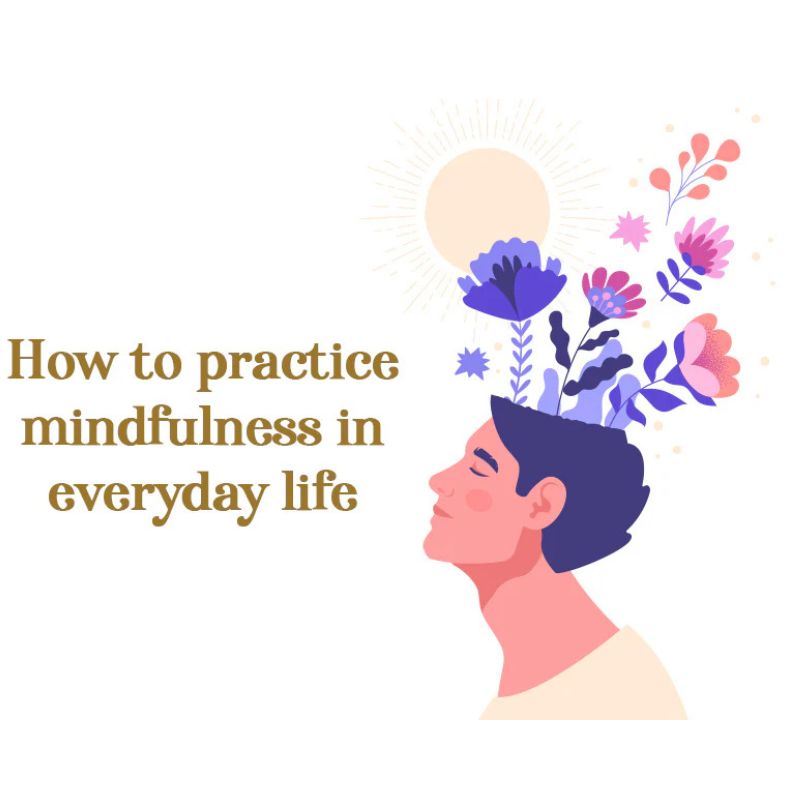Mindfulness isn’t just for monks or meditation experts—it’s for everyone. Practicing mindfulness in daily life means being present in each moment without judgment. It helps reduce stress, improve focus, and enhance your emotional health.
Whether you’re at work, with family, or commuting, mindfulness can fit naturally into your routine. Let’s explore how.
What Is Mindfulness?
Mindfulness is the ability to be fully aware of the present moment—your thoughts, feelings, and surroundings—without distraction or judgment.
According to Mindful.org, mindfulness is “the basic human ability to be fully present.” It’s about being engaged and grounded, not lost in past regrets or future worries.
Why Should You Practice Mindfulness Daily?

Incorporating mindfulness into daily life has many mental and physical health benefits:
- Decreases stress and anxiety
- Improves sleep quality
- Increases focus and memory
- Boosts emotional intelligence
- Encourages better decision-making
Research from Harvard Health shows that mindfulness practices can lead to lasting changes in brain function.
How to Practice Mindfulness in Daily Life
Let’s break down how to apply mindfulness in everyday routines.
1. Mindful Morning Routine
Start your day with calm and clarity by incorporating mindfulness into your morning routine.
- Begin the Day Without Screens
Avoid jumping on your phone. Instead, stretch, take deep breaths, and enjoy a quiet moment. This sets a calm tone for the day.
- Set an Intention
Ask yourself: How do I want to feel today? Being intentional can guide your actions and emotions.
2. Mindful Breathing Throughout the Day
Your breath is your anchor. Stop for a minute, inhale slowly, hold, and exhale fully. Apps like Headspace offer short breathing guides that fit into any schedule.
3. Mindful Eating Habits
Transform your meals into a peaceful, intentional experience by practicing mindful eating habits.
- Eat Without Distractions
Put your phone away. Focus on your food’s taste, smell, and texture. Mindful eating supports better digestion and helps prevent overeating.
- Savor Every Bite
Chew slowly. Feel gratitude for your meal. This enhances the dining experience and your connection with food.
4. Mindful Walking
Turn walks into meditative moments. Feel each step. Observe your surroundings—the breeze, the sounds, the sunlight.
For a guide, check out Greater Good Science Center’s mindful walking practice.
5. Be Present in Conversations
Mindful listening strengthens relationships. Make eye contact, stop multitasking, and truly engage.
6. Create a Mindful Workspace
Design a calm and focused environment by creating a mindful workspace that supports productivity and well-being.
- Take Regular Breaks
Every hour, pause for 60 seconds. Breathe and refocus. This enhances productivity and reduces burnout.
- Declutter Your Space
A clean workspace can lead to a calmer mind. Visual clutter often adds to mental chaos.
7. Use Mindfulness Apps and Tools
Here are some recommended tools:
- Calm: Guided meditations and sleep sounds
- Insight Timer: Free meditation library
- Smiling Mind: Great for kids and adults
8. Practice Evening Reflection
Before bed, reflect on your day:
- What moments did I truly feel present?
- What can I do differently tomorrow?
Gratitude journaling is another excellent way to end the day mindfully.
Staying Consistent with Mindfulness
Building a habit of mindfulness takes time, but here are tips to stay consistent:
- Start small—just 5 minutes a day
- Pair it with existing routines (e.g., brushing teeth)
- Be kind to yourself—it’s okay to forget
- Celebrate small wins
Frequently Asked Questions (FAQs)
1. How long does it take to see benefits from mindfulness?
Many people notice reduced stress and improved focus within a few weeks of daily practice.
2. Can I practice mindfulness without meditating?
Yes. Mindfulness can be practiced while eating, walking, or doing chores. Meditation is helpful but not required.
3. Is mindfulness a religious practice?
While rooted in Buddhist traditions, modern mindfulness is secular and accessible to all.
4. What if my mind keeps wandering?
That’s normal. The goal isn’t to stop thoughts, but to notice them and gently return to the present.
5. Are there free resources to learn mindfulness?
Yes. Websites like Mindful.org and Greater Good Science Center offer free guides and resources.
Conclusion: Embrace the Present, One Moment at a Time
Mindfulness isn’t about perfection—it’s about presence. By practicing simple habits like mindful breathing, eating, and walking, you can bring greater peace, focus, and emotional balance into your daily life. Even a few mindful moments each day can transform how you experience the world around you.If you’re ready to take the next step in your wellness journey, explore more mental clarity and lifestyle tips on our platform at MindScribes. It’s your go-to space for mindful living, personal growth, and daily inspiration.

